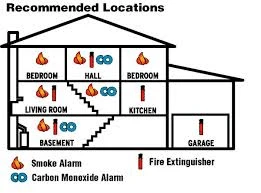
Putting you or your family at risk of a dangerous house fire or carbon monoxide poisoning is senseless with the advanced detection technology available today.
SMOKE DETECTORS
What is small, round, UFO-like, able to eat through a 9-volt battery in a single month, and annoyingly difficult to disengage when you burn the bacon? It’s a smoke detector! While smoke detectors may seem annoying at times, it’s important to know that properly installed and serviced smoke alarms save lives.
Statistically… The majority of fire deaths are in homes without a working smoke detector. Fire kills and injures thousands of Canadians each year.
Don’t put your family’s safety at risk. Learn the facts about smoke detectors.
Types of smoke detectors
- Ionization alarms The majority of smoke alarms are ionization alarms, which specialize at detecting fires with flames. Unfortunately, they may give off false readings leading many owners to get irritated and yank the battery. Ionization alarms are tens of minutes slower at detecting smoldering fires, but do work quite well responding to quickly spreading fires, such as those involving flammable liquids and paper.
- Photoelectric detectors Photoelectric smoke detectors identify smoldering flames, such as those that would occur when your couch, bed, or kitchen cabinets get torched. Because it takes a greater amount of smoke to set them off, there are fewer false alarms, but this makes them too slow at detecting rapidly developing fires with flames.
- Combination alarms Combining a photoelectric and ionization alarm can bring you the best of both worlds.
Know when time’s up on your smoke detector
- Check for a date on the inside of the alarm, next to the battery, or stamped on the back. Expired smoke detectors aren’t reliable. If your smoke detector doesn’t have a date on it, it’s a dinosaur – likely well over 10 years old - and screaming for retirement. Check the operation of your smoke detectors and alarms every six to 12 months.

Be smart with smoke detectors
- Have at least one smoke detector on each level of your house.
- Be sure to have battery powered back up in your smoke detectors.
- Avoid placing smoke detectors near drafts, doors and windows.
- Select the best location for smoke detectors – near bedrooms, in hallways and at the top of stairwells.
- Lightly vacuum the detector annually to keep dust from building up within the smoke detector.
- Never remove the batteries except to change them. Thirty percent of smoke detectors don’t work because the user has removed the battery.
- If you can’t afford smoke detectors, contact your local fire department. They will let you know about local programs to help you get one.
- Establish an emergency exit plan with your family.
CARBON MONOXIDE DETECTORS
Did you know that carbon monoxide (CO) is found in many household appliances like gas ranges or stoves, gas clothes dryers, water heaters, furnaces and gas or wood fireplaces? Or that it can be produced by fuel burning space heaters, exhaust from cars, gas or charcoal grills, and clogged chimneys or flues? If items like these are in poorly ventilated areas, carbon monoxide can build up, and in the blink of an eye, you’re surrounded by toxic air that will poison you and your family.
Statistically… Carbon monoxide poisoning is the leading cause of unintentional poisoning deaths.
How can you protect your family from this silent, but deadly, killer?
Install a CO detector in the home
- A carbon monoxide detector will alert you and your family when there is a risk of being poisoned.
- Test the reliability of the CO detector by following the tests provide in the manufacturer instructions.
Know the signs of CO poisoning
- During the fall and winter, flu and colds are often common. Carbon monoxide poisoning can mimic these sicknesses without the fever. Look for these warning signs: dizziness, headaches, nausea, light-headedness, sleepiness, fatigue, weakness, irregular breathing, vomiting, shortness of breath, confusion, or chest pain.
Get the facts on CO poisoning prevention
- Have CO detectors installed in your home. At a minimum, have one installed on every level of your home and outside each bedroom. Avoid installation near heating vents or in areas covered by furniture or draperies.
- Change the batteries in your CO detector every six to 12 months.
- Look for Underwriters’ Laboratories (UL) or the American Gas Association seal of approval when purchasing gas equipment.
- Have your gas appliances checked bi-annually. Have a professional inspect and service appliances and heating systems annually to ensure proper operation.
- Never use fuel-powered equipment inside a home, garage, vehicle, or other enclosed space unless it’s specifically designed for this purpose. Always follow safety instructions on equipment.
- Do not leave a vehicle running inside a garage. Move the vehicle outside to warm up.
Call Mr. Electric to purchase and install high quality smoke and carbon monoxide detectors in your home today!
